Centuries before Christ, the pagan tribes of Europe worshipped a beautiful goddess of spring named Eostre. Festivals celebrating the end of winter and the birth of spring were held in her honor at the end of March, the time of the vernal equinox. Some historians believe the word Easter is a variation of her name. The Christian Easter festival probably embodies a number of converging pagan traditions, mostly Babilonian, Greek and Asyrian. However, scholars emphasize the original relation of Easter to the Jewish festival of Passover, or Pesach, from which is derived Pasch, another name for Easter.
The the most important festival of the Christian Church Liturgical Year is Easter Sunday, the culmination of the Holy Week (the week between Palm Sunday and Easter Sunday) and of the services connected with the Passion, Crucifixion, and Resurrection of the Jesus Christ on the third day after his Crucifixion. The improtance of Easter is emphasized by Church in the worship by the long preparation to the Lent before Easter and following 50 days after until Pentecost. Scripture readings, solemn prayers, adoration and veneration of the cross recall the crucifixion of Christ on Good Friday. The Holy Week has also a special importance because great deeds were done by God durig this week.
 Holy Saturday commemorates the burial of Christ; midnight vigil services inaugurate the Easter celebration of the resurrection.
The Early Christian Church celebrated the Easter Vigil by serving
baptismal ceremonies that includes lighting candles to symbolize Christ' passing from death
to life and tolling bells to signify the joyous end of Lent. Whose who were baptized
at the Easter Vigil were dressed in new white robes as a symbol of their new life in Christ.
After the ceremony they usually took a long walk, that probably was an origin of Easter Procession
in later centuries. Unfortunately, for many centuries no
Easter Vigil services were held on recalling the suspended state of Christ's followers
in the period between the Crucifixion and the Resurrection. It had been committed to oblivion for
over a fifteen hundred years till 1955 when the Easter Vigil ceremonies were restored again.
Holy Saturday commemorates the burial of Christ; midnight vigil services inaugurate the Easter celebration of the resurrection.
The Early Christian Church celebrated the Easter Vigil by serving
baptismal ceremonies that includes lighting candles to symbolize Christ' passing from death
to life and tolling bells to signify the joyous end of Lent. Whose who were baptized
at the Easter Vigil were dressed in new white robes as a symbol of their new life in Christ.
After the ceremony they usually took a long walk, that probably was an origin of Easter Procession
in later centuries. Unfortunately, for many centuries no
Easter Vigil services were held on recalling the suspended state of Christ's followers
in the period between the Crucifixion and the Resurrection. It had been committed to oblivion for
over a fifteen hundred years till 1955 when the Easter Vigil ceremonies were restored again.
Easter Sunday is a celebration of the Resurrection.
The funeral celebrations of pope John Paul II, the Great, remainds me once more very old
beautiful Easter legend. The legend says
that if somebody dies during Easter days, Holy Week or first week after Easter
his/her soul will be taken directly to Heaven by Christ.
The date of Easter varies every year because it has to fit in with the Jewish Passover, since historically it occurred at that season. If the Paschal moon which is calculated from the system of golden numbers and epacts occurs on the Sunday the Easter day is the succeeding Sunday. The calculation of the date of both feasts depends on the phases of the moon, since they must fall at the time of the Paschal full moon, which varies yearly between 21 March and 25 April. This agreement about the date was not finally reached untill 669 AC in England, following the synod of Whitby in 664, the problem of divergent dates having arisen through differences of calculation between Rome, Jerusalem, Alexandria, Gaul, and the Celtic Church in Ireland. This had led to the cofusion of Easter being celebrated in one centre perhaps as much as a week or fortnight after another centre.
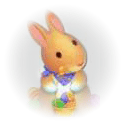 The Easter bunny made its first appearance in Germany and came to the United States with
the Pennsylvania Dutch in the 1700s.
According to one legend, the Easter bunny was originally a large, handsome bird belonging to the goddess Eostre.
One day she magically changed her pet bird into a hare. Because the Easter bunny is still a bird at heart,
he continues to build a straw nest and fill it with eggs.
Eggs, a common symbol of fertility, are associated with many spring festivals.
The Easter egg, the Easter hare or later rabbit and Easter baskets lack religious associations
but most common symbols of Easter. Easter Eggs is a common symbol of renewed life after death and resurrection in many cultures.
The hare is a common symbol of fertility associated with many spring pagan culturs.
The basket provides a nest for decorated eggs and for candies and other items given as gifts at Easter.
In ancient Europe, eggs of different colors were taken from the nests of various
birds and used to make talismans. These ggs were painted bright colors to resemble the sun and springtime.
Often, the colors and patterns had romantic symbolism.
In Medieval Europe, eggs were forbidden during Lent. Therefore they were a prized
Easter gift for family and servants. In 16th century and later it become a custom to exchange or to give
decorated egg to express the friendly attitude and affection.
The Easter bunny made its first appearance in Germany and came to the United States with
the Pennsylvania Dutch in the 1700s.
According to one legend, the Easter bunny was originally a large, handsome bird belonging to the goddess Eostre.
One day she magically changed her pet bird into a hare. Because the Easter bunny is still a bird at heart,
he continues to build a straw nest and fill it with eggs.
Eggs, a common symbol of fertility, are associated with many spring festivals.
The Easter egg, the Easter hare or later rabbit and Easter baskets lack religious associations
but most common symbols of Easter. Easter Eggs is a common symbol of renewed life after death and resurrection in many cultures.
The hare is a common symbol of fertility associated with many spring pagan culturs.
The basket provides a nest for decorated eggs and for candies and other items given as gifts at Easter.
In ancient Europe, eggs of different colors were taken from the nests of various
birds and used to make talismans. These ggs were painted bright colors to resemble the sun and springtime.
Often, the colors and patterns had romantic symbolism.
In Medieval Europe, eggs were forbidden during Lent. Therefore they were a prized
Easter gift for family and servants. In 16th century and later it become a custom to exchange or to give
decorated egg to express the friendly attitude and affection.
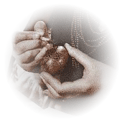 In Eastern Europe the tradition of egg decoration came from Polish legend that probably
has its origin in the story of Simon of Cyrene. The legend says that
on the Good Friday a peasant was taking a basket of eggs to the market to sell. On his way to the market
he encountered Christ carying his cross to Calvary. He put the basket down and ran to
help Christ to carry the cross.
When he returned from Calvary the eggs were miraculously decorated in beautiful colors and designs.
It is really impossible to imagine Polish Easter table without a basket of colored and adorned eggs.
This tradition was spread around all over the central Europe, but he most elaborate Easter egg came from
Poland and Ukraine, where eggs were often painted silver and gold, red, yellow, blue, green, white.
There are many different techniques to decorate an egg, but nost popular are pysanky and krasanky.
In Eastern Europe the tradition of egg decoration came from Polish legend that probably
has its origin in the story of Simon of Cyrene. The legend says that
on the Good Friday a peasant was taking a basket of eggs to the market to sell. On his way to the market
he encountered Christ carying his cross to Calvary. He put the basket down and ran to
help Christ to carry the cross.
When he returned from Calvary the eggs were miraculously decorated in beautiful colors and designs.
It is really impossible to imagine Polish Easter table without a basket of colored and adorned eggs.
This tradition was spread around all over the central Europe, but he most elaborate Easter egg came from
Poland and Ukraine, where eggs were often painted silver and gold, red, yellow, blue, green, white.
There are many different techniques to decorate an egg, but nost popular are pysanky and krasanky.
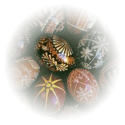 Pysanky (to design or write) eggs were created during the Holy Week by carefully applying wax in
patterns to an egg. The egg was then dyed,
wax would be reapplied in spots to preserve that color, and the egg was boiled again in
other shades. The result was a multi-color stripped or patterned egg. The secred of making pisanky,
their design and formula for dyeing eggs were passed down from mother to daughter through generations.
The art of mixing dyes, its preparation and used method to obtain the
necessary brilliance, clarity and lasting color of egg as well as an ornament and ornamental pattern
were family secrets and were heavily protected by family against stealing.
It was believed that Easter blessed pysanka have a power to provide wealth, health and fertility for a
family. It was also believed that Pysanka's ornament can have magical importance and meaning.
Spirals and other circular designs can trap evil, and thus protect the family and home from dangers and evils.
One interesting example of symbolizm of the geometric design is the ornament called "forty triangles"
(actually 48), that can be interpreted as the forty days of lent, the forty martyrs, the forty days that
Christ spent in the desert, and the forty life tasks of married couples. Another often used geometic
symbols include triangle (the Holy Trinity or three elements of air, fire and water), diamonds (knowledge),
curls (defense or protection), tripods (man, woman and child or birth, life, and death), and
spirals (the mystery of life and death, as well as divinity and immortality), and dots represent the tears
of the blessed Virgin. Hearts are also sometimes seen, and they represent divine and profan love.
Pysanky (to design or write) eggs were created during the Holy Week by carefully applying wax in
patterns to an egg. The egg was then dyed,
wax would be reapplied in spots to preserve that color, and the egg was boiled again in
other shades. The result was a multi-color stripped or patterned egg. The secred of making pisanky,
their design and formula for dyeing eggs were passed down from mother to daughter through generations.
The art of mixing dyes, its preparation and used method to obtain the
necessary brilliance, clarity and lasting color of egg as well as an ornament and ornamental pattern
were family secrets and were heavily protected by family against stealing.
It was believed that Easter blessed pysanka have a power to provide wealth, health and fertility for a
family. It was also believed that Pysanka's ornament can have magical importance and meaning.
Spirals and other circular designs can trap evil, and thus protect the family and home from dangers and evils.
One interesting example of symbolizm of the geometric design is the ornament called "forty triangles"
(actually 48), that can be interpreted as the forty days of lent, the forty martyrs, the forty days that
Christ spent in the desert, and the forty life tasks of married couples. Another often used geometic
symbols include triangle (the Holy Trinity or three elements of air, fire and water), diamonds (knowledge),
curls (defense or protection), tripods (man, woman and child or birth, life, and death), and
spirals (the mystery of life and death, as well as divinity and immortality), and dots represent the tears
of the blessed Virgin. Hearts are also sometimes seen, and they represent divine and profan love.
The symbols, colors, ornaments, even material used to make decorated egg underwent a process of adaptation
over time. Throught centuries by using simple tools and method the ordinary egg was
transformed in the real
piece of art. Decorated egg, especially when was made of gold and adorned
with diamonds, rubins, pearls, and other precoius and semi-precious stones,
became an object of adoration and desire, the object that could change the history
of the world.
At the end of 19th century Peter Carl Fabergé and his goldsmiths of the Fabergé
company made eggs that became the masterpieces of the jeweller's art and changed the history of several Rossian families.
The first precious Easter egg was commissioned in 1885 by Tsar Alexander III of Russia as an Easter surprise
for his wife Empress Maria. She was so delighted by this gift, that Alexander commissioned an Easter
gift each year thereafter, stipulating only that it be unique and contain a surprise.
The first Easter egg for Maria Federovna looked like an ordinary hen egg, may be a little bigger (about 64 mm)
and heavier.
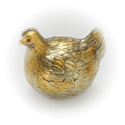 It was made of white enamelled gold with surprise: removable yolk.
The yolk contained miniature yellow-and-white tinted gold hen with two rubies as eyes,
which in turn contained and exact replica in diamonds of the imperial crown and another
small ruby egg. (FORBES Magazine Collection, New York, FAB 78001). It was sold by Stalin's
representative
at Christie's on March 15 1934 for as much as £400 (sic!). The egg
was part of ex-collection of Lady Grantchester. Probably during II WW imperial crown and small ruby egg
have been lost for ever in unknown circumstances.
In 1978 it was bought by Forbes. In April 21, 2004, the Forbes collection was bought by Victor
Vekselberg for 72 mil dollars.
It was made of white enamelled gold with surprise: removable yolk.
The yolk contained miniature yellow-and-white tinted gold hen with two rubies as eyes,
which in turn contained and exact replica in diamonds of the imperial crown and another
small ruby egg. (FORBES Magazine Collection, New York, FAB 78001). It was sold by Stalin's
representative
at Christie's on March 15 1934 for as much as £400 (sic!). The egg
was part of ex-collection of Lady Grantchester. Probably during II WW imperial crown and small ruby egg
have been lost for ever in unknown circumstances.
In 1978 it was bought by Forbes. In April 21, 2004, the Forbes collection was bought by Victor
Vekselberg for 72 mil dollars.
Nicholas II continued the tradition of Easter egg gift for his wife Alexandra Fedorovna as well as his
widowed mother. He also commisioned several smaller eggs as an Easter gift for his courties.
From 1885 to the Russian Revolution about 50 golden eggs and other luxury egg-shaped objects include
cloisonne enamel eggs, miniature eggs pendants and porcelain and lacquer eggs for the Russian royal family
and other wealthy Russian asistoctacts were born from the hands of his goldsmiths.
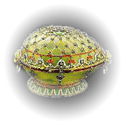 The one of most beautiful Easter eggs and the last one comissioned by Alexander III is Renaissance egg.
This not so big egg
(ca 13.3 - 14 cm)
was inspired by a jeweled casket in Dresden, Germany (in the Grunes Gewolbe Museum).
It is richly decorated with white agate, diamonds, rubies and colorful stones. The name for the egg comes from
the source of its inspiration, as well as the Renaissance-style enamelled foliate motifs.
The egg is made of milky chalcedony and trellised with opaque white enamel gold bands.
At each trellis intersection there is a quatrefoil of diamonds with a ruby center. The
egg is bisected by a red enamelled gold band. Under the bisecting band and around the
red enamelled top, the Renaissance-style motifs, set with diamonds and cabochon rubies,
are placed. The top has the date, 1894, set in rose diamonds. The egg, last of the eggs
for Czar Alexander III, rests on a golden base with enamelled red and green flowers and
palmettes against a white background. The had two chased gold lion masks, with loop
handles in their mouths. The surprise that came in this egg has been lost and is unknown.
In 1927 it was bought by Armand Hammer from unknown source. From 1978 was as a part of the Forbes collection.
April 21, 2004 it was bought by Victor Vekselberg.
The one of most beautiful Easter eggs and the last one comissioned by Alexander III is Renaissance egg.
This not so big egg
(ca 13.3 - 14 cm)
was inspired by a jeweled casket in Dresden, Germany (in the Grunes Gewolbe Museum).
It is richly decorated with white agate, diamonds, rubies and colorful stones. The name for the egg comes from
the source of its inspiration, as well as the Renaissance-style enamelled foliate motifs.
The egg is made of milky chalcedony and trellised with opaque white enamel gold bands.
At each trellis intersection there is a quatrefoil of diamonds with a ruby center. The
egg is bisected by a red enamelled gold band. Under the bisecting band and around the
red enamelled top, the Renaissance-style motifs, set with diamonds and cabochon rubies,
are placed. The top has the date, 1894, set in rose diamonds. The egg, last of the eggs
for Czar Alexander III, rests on a golden base with enamelled red and green flowers and
palmettes against a white background. The had two chased gold lion masks, with loop
handles in their mouths. The surprise that came in this egg has been lost and is unknown.
In 1927 it was bought by Armand Hammer from unknown source. From 1978 was as a part of the Forbes collection.
April 21, 2004 it was bought by Victor Vekselberg.